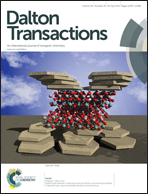Kinetics of cisplatin binding to short r(GG) containing miRNA mimics – influence of Na+versus K+, temperature and hydrophobicity on reactivity†
Abstract
Nucleic acids are well recognized targets for platinum-based anticancer drugs, with RNA and DNA being kinetically comparable. In the case of RNA, previous studies have shown that the reaction between small duplex RNAs (dsRNAs) and monoaquated cisplatin (cis-Pt(NH3)2Cl(OH2)+, 1a) can be followed by the metal induced hyperchromicity occurring directly after addition of 1a to e.g. microRNA mimics. In the present study, we have used this approach to compare thermal stability and reactivity between intracellularly- and extracellularly relevant salt concentration (CNa+ and CK+ca. 0.1 M), and also as a function of increased hydrophobicity (10% v/v EtOH). In addition, reactivity was studied as a function of temperature in the interval ca. 5–20 °C below the respective dsRNA melting temperatures (Tms). Four different 13- to 20-mer dsRNAs with two different central sequence motifs were used as targets containing either a central r(GG)·r(CC)- or r(GG)·r(UAU)-sequence. The reactions exhibited half-lives in the minute- to hour range at 38 °C in the presence of excess 1a in the μM range. Further, a linear dependence was found between C1a and the observed pseudo-first-order rate constants. The resulting apparent second-order rate constants were significantly larger for the lower melting r(GG)·r(UAU)-containing sequences compared with that of the fully complementary ones; the higher and lower reactivities represented by RNA-1-3 and RNA-1-1 with k2,appca. 30 and 8 M−1 s−1 respectively at CNa+ = 122 mM. For all RNAs a common small, but significant, trend was observed with increased reactivity in the presence of K+ compared with Na+, and decreased reactivity in the presence of EtOH. Finally, the temperature dependence of k2,app was evaluated using the Eyring equation. The retrieved activation parameters reveal positive values for both ΔH≠ and ΔS≠ for all dsRNAs, in the range ca. 23–34 kcal mol−1 and 22–57 cal K−1 mol−1 respectively. These values indicate solvational effects to be important for the rate determining step of the reaction, and thus in support of a structural change of the dsRNA to take place in parallel with the adduct formation step.


 Please wait while we load your content...
Please wait while we load your content...